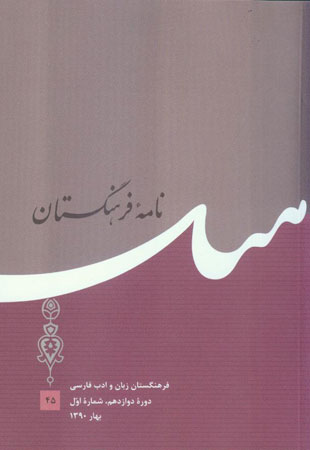فهرست مطالب

نامه فرهنگستان
سال دوازدهم شماره 1 (بهار 1390)
- ویژه نامه ادبیات تطبیقی (3)
- تاریخ انتشار: 1390/02/02
- تعداد عناوین: 13
-
- سرمقاله
- مقاله
-
صفحه 23
-
صفحه 42
-
صفحه 66
-
صفحه 71
- گزارش
- معرفی و نقد کتاب
-
صفحه 182
-
صفحه 194
-
Page 9The short story of Dash Akol, is one of the most brilliant stories of Persian literature in the twentieth century, which has been mostly known by the name of its author, Sadeq Hedāyat. This story was first published in 1932 in a collection including 11 short stories. Years later, during 1970’s, a film was made based on this story which earned a highly distinguished position in the world of Iranian cinema. In the writer’s view, the story was written definitely with the support of other texts. Hedāyat has written an Iranian story; however, having complete mastery of other national literatures, especially French literature, he created this magnificent work and stepped towards a concept which is called today “intertextuality”. Since any literary text is created according to the reception of its audiences, a different reading of this story will help us to understand the genesis of another localized story at the level of Iranian reader’s horizon of expectation.Keywords: story, intertextuality, localization, horizon of expectation, Hedayat
-
Page 42Metricians (or the Arūz specialists) have rightly considered distich as the metrical unit of Arabic poetry. The metricians of Persian poetry following the Arabic Arūz have also considered it as the metrical unit of Persian poetry as well. This has caused some confusion in Persian Arūz or meterology. The confusion lasted forcenturies till the founders of the new Arūz noticed that distich could not be a proper unit of meter for the Persian poetry. They believe that unlike Arabic poetry hemistich is the correct metrical unit in Persian poetry. Besides, some principal differences exist between the metrical units.
-
Page 66Susan Bassnett starts her book, Comparative Literature: A Critical Introduction, with a definition. “… comparative literature involves the study of texts across cultures, that it is interdisciplinary and it is concerned with patterns of connection in literatures across both time and space” (1). Bassnett believes that while the Eurocentric comparative literature is declining in the West, it is growing in the rest of the world. On the other hand, the new generation of comparatists in the West have turned to Literary Theory, Women’s Studies, Translation Studies and more importantly to Post-Colonial Studies which she believes is comparative literature under a new name.Keywords: Post, Colonialism, comparative literature, translation studies
-
Page 116Comparative Literature in Arabic countries like Syria, Lebanon, Morocco, Kuwait and Bahrain has a short history, but it mainly developed in Egypt. Therefore, in this article, keeping historical, social, cultural and literary conditions in mind, I try to find out how Comparative Literature grew in Egypt as an example of Arabic countries. Egyptian literature did not achieve intellectual, literary and cultural status during Mongolian and three centuries of Ottoman rule. The French introduced printing industry and established libraries, scientific and literary institutions and thus started a new movement in Egypt. Comparative Literature as a new field ofknowledge developed in Egypt under the influence of the French school by Muhammad Ghunaymi Hilal in the 1950s, then in the 1980s Sáid Allush and Hussam Al-Khateeb introduced the American school to the Arab world. Despite the difficulties and problems like unfamiliarity with theoretical principles and methodology, some valuable studies and researches have been done in the Arab world.Keywords: Comparative literature, Egypt, Arab world, origin of comparative literature, society of comparative literature

